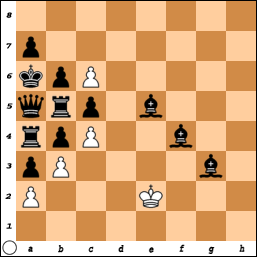A chess problem solvable by intuition but not by computers
March 13, 2017
The new Penrose Institute has been founded by Sir Roger Penrose, emeritus Professor at the Mathematical Institute of Oxford.
It will study human consciousness through physics and tease out the fundamental differences between artificial and human intelligence.
A chess problem, originally drawn by Sir Roger, has been devised to defeat an artificially intelligent computer but be solvable for humans. The Penrose Institute scientists are inviting readers to workout how white can win or force a stalemate and then share their reasoning.
http://www.telegraph.co.uk/science/2...consciousness/

white to play and draw. Easy for humans. (Note: It is a legal position)
__________
Can you solve the puzzle?
Scientists want to hear from you if you've cracked it
The puzzle above may seem hopeless for white, with just a King and four pawns remaining, but it is possible to draw and even win.
Scientists have constructed it in a way to confound a chess computer, which would normally consider that it is a win for black.
However an average chess-playing human should be able to see that a draw is possible.
A chess computer struggles because it looks like an impossible position, even though it is perfectly legal.
The three bishops forces the computer to perform a massive search of possible positions that will rapidly expand to something that exceeds all the computational power on planet earth.
Humans attempting the problem are advised to find some peace and quiet and notice how the solution that arises. Was there a flash of insight? Did you need to leave the puzzle for a while and come back to it?
The main goal is to force a draw, although it is even possible to trick black into a blunder that might allow white to win.
The first person who can demonstrate the solution legally will receive a bonus prize.
Both humans, computers and even quantum computers are invited to play the game and solutions should be emailed to puzzles@penroseinstitute.com.
_________
This past weekend in a thread about the lasker chess problem, a position not solvable by computer was cooked by a ChessTalk reader!
http://forum.chesstalk.com/showthrea...-chess-problem
March 13, 2017
The new Penrose Institute has been founded by Sir Roger Penrose, emeritus Professor at the Mathematical Institute of Oxford.
It will study human consciousness through physics and tease out the fundamental differences between artificial and human intelligence.
A chess problem, originally drawn by Sir Roger, has been devised to defeat an artificially intelligent computer but be solvable for humans. The Penrose Institute scientists are inviting readers to workout how white can win or force a stalemate and then share their reasoning.
http://www.telegraph.co.uk/science/2...consciousness/

white to play and draw. Easy for humans. (Note: It is a legal position)
__________
Can you solve the puzzle?
Scientists want to hear from you if you've cracked it
The puzzle above may seem hopeless for white, with just a King and four pawns remaining, but it is possible to draw and even win.
Scientists have constructed it in a way to confound a chess computer, which would normally consider that it is a win for black.
However an average chess-playing human should be able to see that a draw is possible.
A chess computer struggles because it looks like an impossible position, even though it is perfectly legal.
The three bishops forces the computer to perform a massive search of possible positions that will rapidly expand to something that exceeds all the computational power on planet earth.
Humans attempting the problem are advised to find some peace and quiet and notice how the solution that arises. Was there a flash of insight? Did you need to leave the puzzle for a while and come back to it?
The main goal is to force a draw, although it is even possible to trick black into a blunder that might allow white to win.
The first person who can demonstrate the solution legally will receive a bonus prize.
Both humans, computers and even quantum computers are invited to play the game and solutions should be emailed to puzzles@penroseinstitute.com.
_________
This past weekend in a thread about the lasker chess problem, a position not solvable by computer was cooked by a ChessTalk reader!
http://forum.chesstalk.com/showthrea...-chess-problem


Comment